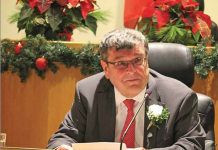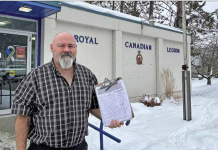Haliburton’s Barry Hart told a theatre full of high school students on Remembrance Day that he still shudders when considering how fortunate his father, William Hart, was to survive a plane crash that killed the rest of his crew during the final months of the Second World War.
A tail gunner with the Royal Air Force’s (RAF) 582 Squadron, Hart and the rest of his seven-man crew took a Lancaster bomber on an 18-hour round trip from London, England to Chemnitz, Germany on March 5, 1945. Their mission was to be a pathfinder, marking enemy targets with magnesium markers. They had just returned to British airspace when disaster struck on March 6.
“They’re coming down to land, and the plane just blows up,” Hart said, noting that some of the leftover magnesium markers hadn’t been set properly and, upon the plane descending to 3,000 feet, inadvertently went off.
One of the soldiers called out the fire right away, with the pilot saying he would try to hold the plane steady and directed the rest of the crew to bail. Hart said his grandfather was in the tail gunner turret while this was
happening and, with the plane jolting, fell out. He managed to recover and quickly pull his parachute, Hart said.
“Miraculously, he survived the parachute drop. The plane nosedived and the other guys, unfortunately, didn’t make it out. They were all incinerated in the crash,” Hart said.
He told how his father only became a tail gunner after losing a coin toss with his comrades – the position was widely
considered to be the most dangerous on the Lancaster, as it’s the first target for enemies.
In September, he visited the crash site near Oxford, saying there’s a memorial stone and plaque there to honour the crew. His dad wasn’t named though, being a survivor, so Hart had another plaque made and installed. William died in 1992.
While not quite as death-defying, Pat Casey said his grandfather, Earl Casey had many horror stories from his time fighting in the war. He was also a tail gunner, serving with the Royal Canadian Air Force’s 428 Ghost Squadron, which flew nighttime bombing missions.
“Flying at 20,000 feet, the glass cover that protected tail gunners from the elements would get frosted over on lengthy flights.
The soldiers couldn’t see, so nine-times-out of-ten they would kick the panel out and fly in the breeze at the back of the aircraft,” Casey said.
His grandfather was 17 when he enlisted, one year younger than the minimum requirement. Casey said he must have lied on his application. Earl was the youngest in his flight crew, with the oldest being 23.
After a successful bombing mission over mainland Europe, Casey’s Lancaster was struck by shrapnel over the English Channel on the return flight home. The crew ditched the plane in the water and spent 14 days with limited supplies on a rubber dinghy.
“They ran out of food and water pretty quickly. They got to the point where, to survive, they had to drink their own urine,” Casey said. “They didn’t think they could go on much longer – then they got picked up by a German patrol boat and became prisoners of war (PoW).”
Earl sustained a broken shoulder and leg in the crash, which didn’t heal properly given the poor living conditions PoWs were exposed to. He wasn’t sure how long his grandpa spent in captivity, but knows exactly when his time as a prisoner came to an end.
“He told me the Germans lined him and his crew up in front of a firing squad. The Germans loaded their guns, my grandpa and the other boys all said a teary goodbye to one another – they were pretty worn out and beat down by this point,” Casey said. “But as they waited for the trigger, a German captain stopped everything. The war was
over.”
The soldiers were all transported back to England and returned home to Canada within weeks.
“If you want to talk about luck – that’s how close my grandfather came. His luck was in at the most critical time,” Casey said.





